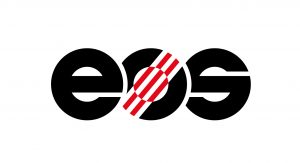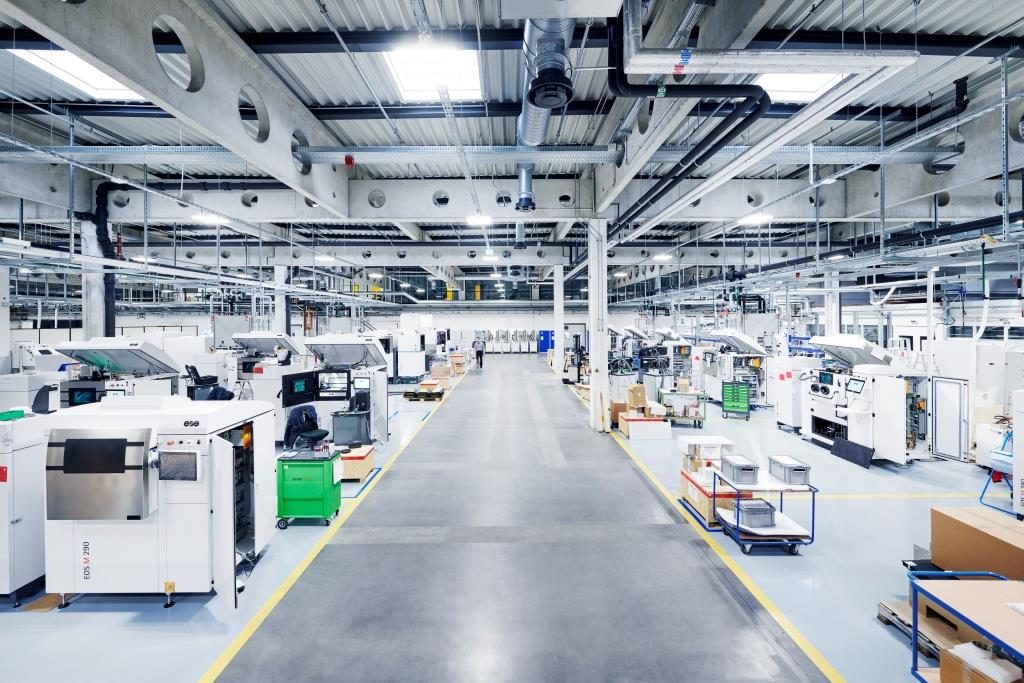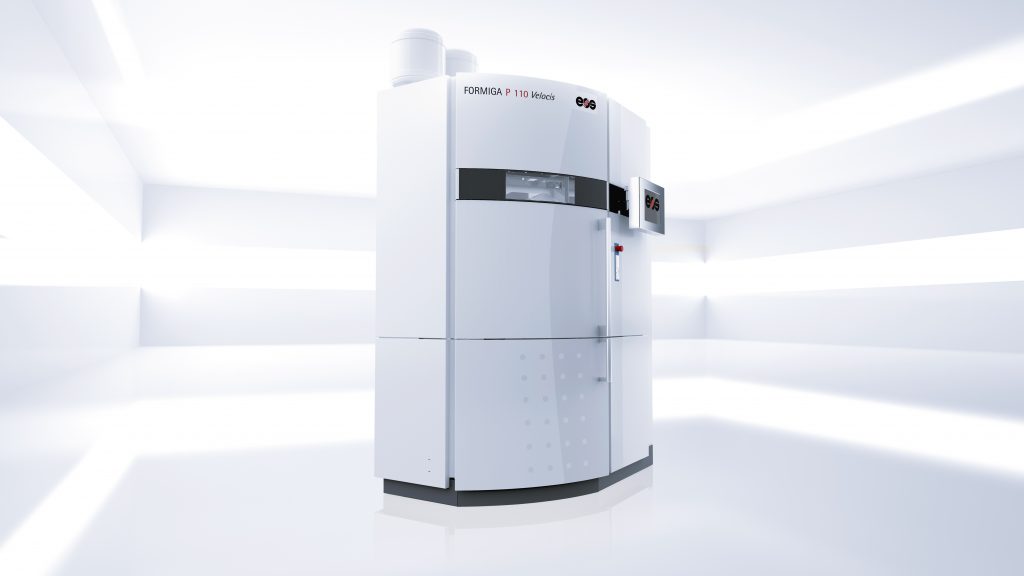 Back in 1989, Hans Langer’s vision of going straight from CAD to manufacturing without tooling for the fabrication of physical components led to the creation of Electro Optical Systems (EOS GmbH) and revolutionized the industrial manufacturing sector in Germany. EOS has grown to become one of the global technology leaders in industrial 3D printing of metals and polymers, specializing in the interaction of laser and powder materials and is currently celebrating 30 years in the industry.
Back in 1989, Hans Langer’s vision of going straight from CAD to manufacturing without tooling for the fabrication of physical components led to the creation of Electro Optical Systems (EOS GmbH) and revolutionized the industrial manufacturing sector in Germany. EOS has grown to become one of the global technology leaders in industrial 3D printing of metals and polymers, specializing in the interaction of laser and powder materials and is currently celebrating 30 years in the industry.
Industrial 3D printing is booming, AM in aerospace is growing, the cost-effective, tool-less production of lightweight components reduces fuel consumption, material costs, and CO2 emissions. And what about automotive, 3D printing is heralding new paths in the sector; not to mention prosthetics, medical implants, defense and renewables (just to mention a few). The latest Wohlers Report 2019 says the AM industry will exceed $15.8 billion, so it’s no wonder that Latin America has become an incipient and promising market for 3D printing. Latin America is home to around 9 percent of the world population (that’s roughly 651 million people), so like other machine developers, EOS is interested in breaking into the southern cone, although it’s not an easy market, especially compared to North America, Europe or Asia. Much of the economy still relies heavily on traditional sectors involving natural resources such as agriculture and textiles, nonetheless, opportunities are springing up across the subcontinent and Latin America GDP is expected to improve in 2020 thanks to Mexico, Brazil, Colombia, and Argentina.
“In Latin America, the additive manufacturing business is developing slower than expected. One major reason for that might be that leveraging 3D printing technology requires relatively high investments, which companies in the region are not willing or not able to invest on yet. Furthermore, 3D printing expertise has to be build up, but there is still a lack of AM specialists in the region. However, EOS is confident that these points will change in the next two to three years, meaning that more and more industry companies will use AM technology for series applications,” suggested Davide Iacovelli, Regional Director South of EOS, to 3DPrint.com.
“In general, I see the following trend: In Europe, more and more customers have evolved from 3D printing for prototyping towards using the technology in production. Topics like industry 4.0 are especially important accelerators and companies are getting more interested in setting-up digital factories. That’s following our EOS vision: We strictly believe that additive manufacturing is a key technology for advanced industrial production and is THE technology for digital manufacturing. In comparison, this is not the case in Latin America yet, where AM technology is mostly used for prototyping or for university research and development,” he continued.
With regards to the different areas of industrial 3D printing usage in Latin America, Iacovelli considers that in general, the most active and mature industries are medical and dental, something many other experts have also confirmed to 3DPrint in the past.
“In these industries, the jump to series production could succeed the fastest,” he claims, with corresponding applications for crowns, bridges, and implants.
According to the expert, there are other exciting applications and industries pushing additive manufacturing, like aerospace, which “is certainly not to be underestimated in Latin America, be it in the field of aircraft or satellites, to name just two possible areas of application.”
For EOS, in the Latin American region, the most successful areas of their system usage are academia, followed by service providers (for the production of prototypes). This means that the most common areas for additive manufacturing are still prototyping as well as research and development, and other important fields include medical and dental applications where patient-specific solutions are in high demand. And with companies like EOS providing all essential elements for industrial 3D printing, system, material and process parameters can be intelligently harmonized to facilitate and ensure a reliable high quality of printed parts.
Iacovelli considers that “the oil and gas as well as mining industries are certainly interesting scenarios (like offshore applications in the area of power generation) where the benefits of AM can be implemented. The automotive industry is also an important sector – about three million vehicles per year are produced in Brazil alone, so the potential is huge. Others, like the prospective Industry 4.0 scenarios probably will take some more time, here we see potential but not in the short-term.”
The automotive industry is well within a comfort zone for EOS. Back in 1991, one of Langer’s first customers was Bavarian car manufacturer BMW (one of the early users of 3D printing technology), and other automotive developers followed suit. In 2018, Brazil produced over 2.8 million vehicles, everything from passenger cars to trucks and buses, of some major global brands like Volkswagen, Fiat, GM, and Ford. And although today is not the same as it was 10 years ago with many plants closing, like Ford’s oldest truck-producing factory, many expect this will soon shift as the region exit’s its current recession.
“One of the challenges the market in general faces is that companies in Latin America typically strive for a faster Return On Investment (ROI), in these kinds of investments with industrial machinery needed for 3D printing, than in Europe. We also see local regulations and guidelines, which are different from Europe, like in the medical/dental sector in Brazil. This is especially complex as almost every country in Latin America has its own regulations,” continued Iacovelli.
In the region, EOS is offering systems for industrial 3D printing with metal as well as polymer materials, each category with different sized build volumes. They consider the ratio in Latin America to be 45 percent metal and 55 percent polymer systems. In the area of polymers, the EOS P 110 system (a machine ideally suited for research and development but that some consider perfect for manufacturing) is extremely popular with the most sales. Particularly in Brazil, there are also systems used with a larger build area from the EOS P 3 system family, while in the metal area, the EOS M 2 system family is predominantly bought.
With sales that top 1,000 units globally every year, the company could be well on its way to expanding these AM systems in Latin America. All of the countries in the region are in dire need of a strong 3D printing market to help them change the traditional manufacturing systems and become sustainable companies that can grow at similar levels as the rest of the world. Big events like Inside 3D Printing in Brazil and 3D Print Week in Argentina can help shape the 3D market. For companies like EOS to thrive and for the population to start considering the benefits of 3D printing beyond just a hobby, big changes need to happen, from state officials to leading companies and entrepreneurs. More importantly, big investments in AM systems could benefit countries like Uruguay, Paraguay, Chile and Brazil and lead them into the fourth industrial revolution.
[Image Source: EOS]Subscribe to Our Email Newsletter
Stay up-to-date on all the latest news from the 3D printing industry and receive information and offers from third party vendors.
Print Services
Upload your 3D Models and get them printed quickly and efficiently.
You May Also Like
3D Printing News Briefs, June 11, 2025: Sustainability, Automotive Tooling, & More
We’re starting with sustainability news in today’s 3D Printing News Briefs, as EOS has strengthened its commitment on climate responsibility, and Zestep is making 3D printing filament out of eyewear...
3D Printing 50 Polymer Stand-In Parts for Tokamaks at the PPPL & Elytt Energy
Of all the world’s things, a tokamak is one of the hardest, most complex, expensive and exacting ones to make. These fusion energy devices make plasma, and use magnets to...
3D Printing News Briefs, May 17, 2025: Color-Changing Materials, Humanoid Robot, & More
We’re covering research innovations in today’s 3D Printing News Briefs! First, Penn Engineering developed 3D printed materials that change color under stress, and UC Berkeley researchers created an open source,...
Firehawk Aerospace Partners with JuggerBot 3D, Gets $1.25M from AFWERX for 3D Printed Propellants
Texas-based Firehawk Aerospace, an advanced energetic materials firm that works with aerospace and defense applications, announced a strategic partnership with JuggerBot 3D, an Ohio-based large-format 3D printer manufacturer. Together, the...



































